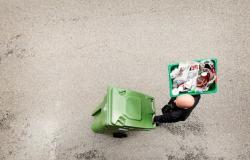Chaos in Sedavi, south of Valencia, after the tragic floods which affected the south-east of Spain a month ago.
AFP
“Nothing is moving forward”: one month after the tragic floods which left 230 dead and billions of euros in damage in the south-east of Spain, fatigue and weariness are overwhelming the victims.
Catarroja, south of Valencia, still bears the scars of the disaster. Dozens of vehicles pile up at the entrance to the city in improvised wreck cemeteries.
“We are tired, we thank the volunteers, but we are very tired, because nothing is moving forward,” confides Amparo Peris, 35 years old. “Sometimes we have electricity, sometimes we don’t… Some days, at mealtime, you are without electricity and we wonder what we are going to eat (…) We don’t like this situation, we hope that this will soon pass,” continues this care worker.
Friday evening, one month to the day after the disaster caused by torrential rains, rallies are to take place in several of the affected municipalities, at the call of local organizations, unions and associations.
Chaotic management
The chaotic management of the disaster is the main grievance of the victims, some of whom say they still feel “abandoned”.
What “is required of us in all cases is that we be effective,” said the right-wing president of the Valencia region Carlos Mazón on Friday, whose management of alert and relief is highly criticized.
“There is still a lot of work to be done, there are hundreds of flooded garages and basements, damaged buildings, closed businesses, cut roads, entire villages that have not yet returned to normal life” , for his part, recognized Wednesday the socialist Prime Minister Pedro Sánchez before the deputies.
On Thursday, his Minister of Economy Carlos Cuerpo listed the damage caused by the floods based on insurance data: 69,000 homes, 125,000 vehicles and 12,500 businesses were affected. The damage could cost the country up to 0.2 points of growth in the fourth quarter, according to the governor of the Bank of Spain, José Luis Escrivá.
Little by little, however, the situation is improving in the affected towns, where the main roads have been cleared.
But even if a thin layer of reddish dust has replaced the mud that covered everything after the tragedy, the return to normal is not yet certain for many residents.
Mud up to your knees
In the basement of Lourdes Real, “the mud reaches up to the ankles on the first level, and up to above the knee on the second,” underlines this hairdresser from Catarroja, 46, who has still not returned to work. way to work. “We lost two cars, the motorcycle, six boxes of clothes (…) photos and personal effects, which I am not going to get back,” laments the mother.
“I clean the yard and at least the yard looks a little clean: even if it doesn’t last long, it does us good that it smells a little good,” she confides again.
In total, the government has promised 16.6 billion euros in aid and loans, and thousands of soldiers, firefighters and police are deployed for clean-up and reconstruction operations, without managing to completely silence criticism aimed at politicians since the tragedy.
This anger, aimed both at the delay in launching the alert before the disaster and at the management of relief, peaked on November 3 during a visit to Paiporta by the royal couple, Felipe VI and Letizia, accompanied by Pedro Sánchez and by Carlos Mazon.
Greeted by insults and throwing of mud and various objects, MM. Sánchez and Mazón had to turn back, while the king and queen were forced to cut short their trip.
A sign that discontent remains strong, a new demonstration is to take place on Saturday in Valencia, the regional capital, where some 130,000 people had already marched at the beginning of the month to demand the resignation of Carlos Mazón and denounce the management considered chaotic by the relief workers. the Sánchez government.
(afp)





